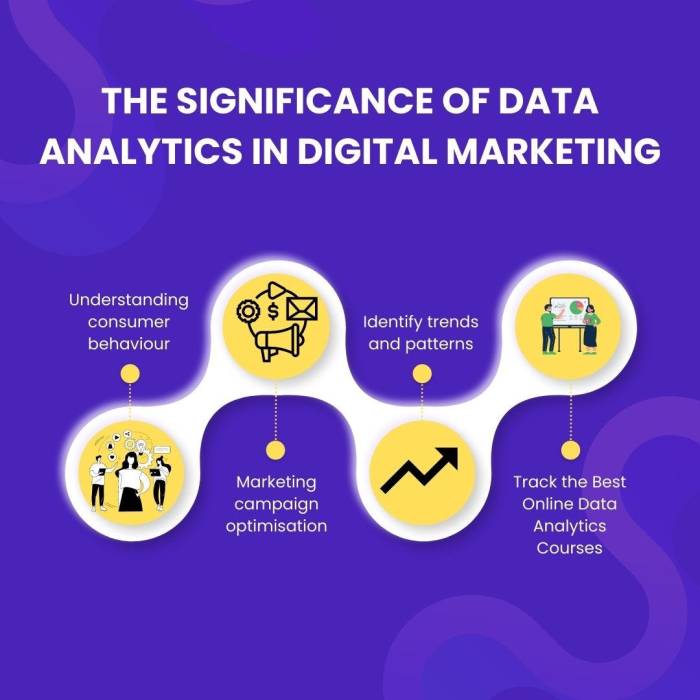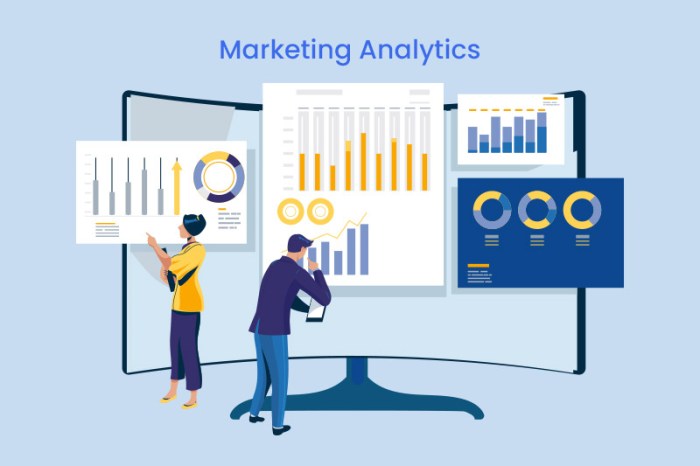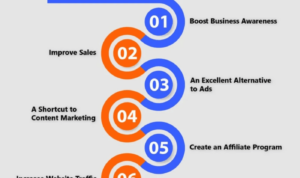Using Data Analytics in Digital Marketing dives into the world of customer behavior and marketing strategies, revealing how data drives successful campaigns in the digital realm. Get ready to explore the power of data in transforming marketing landscapes!
In this article, we’ll unravel the types of data used in digital marketing analytics, explore tools and technologies that make it all possible, and delve into the challenges and future trends shaping the data analytics landscape for digital marketing.
Importance of Data Analytics in Digital Marketing

Data analytics plays a crucial role in digital marketing by providing valuable insights into customer behavior and preferences. By analyzing data, marketers can better understand their target audience and tailor their strategies accordingly.
Understanding Customer Behavior
Data analytics helps in tracking and analyzing customer interactions with a brand’s website, social media platforms, and other digital channels. This information enables marketers to identify patterns, trends, and preferences among customers. For example, analyzing click-through rates, bounce rates, and conversion rates can provide valuable insights into what resonates with customers and what doesn’t.
Improving Marketing Strategies
Data analytics allows marketers to measure the effectiveness of their campaigns in real-time and make data-driven decisions to optimize their strategies. By analyzing key performance indicators (KPIs) such as return on investment (ROI) and customer acquisition cost (CAC), marketers can allocate resources more efficiently and improve campaign performance. For instance, A/B testing different ad creatives based on data analysis can help identify the most effective messaging for a target audience.
Successful Campaign Examples
One successful digital marketing campaign driven by data analytics is the personalized recommendation feature on e-commerce websites like Amazon. By analyzing customer browsing and purchase history, Amazon can recommend products that are highly relevant to individual customers, increasing the likelihood of conversion. Another example is Spotify’s personalized playlists, which are curated based on user listening behavior and preferences, leading to higher user engagement and retention rates.
Types of Data Used in Digital Marketing Analytics

In digital marketing analytics, various types of data are utilized to understand consumer behavior, track campaign performance, and optimize marketing strategies.
Structured Data
Structured data refers to organized and easily searchable information, typically found in databases or spreadsheets. This type of data includes customer contact details, purchase history, website interactions, and more. By analyzing structured data, marketers can gain insights into customer preferences, segment audiences, and tailor personalized marketing campaigns.
Unstructured Data
Unstructured data, on the other hand, consists of text, images, social media posts, videos, and other content that is not easily organized in a traditional database format. Analyzing unstructured data allows marketers to extract valuable insights from customer feedback, social media sentiment, online reviews, and other sources to understand consumer sentiment and trends.
Demographic Data
Demographic data includes information such as age, gender, location, income level, education, and more. By leveraging demographic data, marketers can create targeted campaigns that resonate with specific audience segments, leading to higher engagement and conversion rates.
Behavioral Data
Behavioral data tracks how consumers interact with digital channels, such as website visits, email opens, clicks, and social media engagement. Analyzing behavioral data helps marketers understand customer preferences, identify purchase intent, and optimize user experiences to drive conversions.
Transactional Data
Transactional data includes information on customer purchases, order history, payment methods, and product preferences. By analyzing transactional data, marketers can identify upsell opportunities, personalize product recommendations, and optimize pricing strategies to increase customer loyalty and lifetime value.
Tools and Technologies for Data Analytics in Digital Marketing
Data analytics in digital marketing relies on a variety of tools and technologies to analyze and interpret data to make informed marketing decisions. These tools help marketers track, measure, and optimize their marketing campaigns for better results.
Popular Tools for Data Analytics in Digital Marketing
- Google Analytics: A widely-used tool that provides detailed insights into website traffic, user behavior, and conversion rates.
- Adobe Analytics: Offers advanced analytics capabilities for tracking and analyzing customer interactions across various digital channels.
- HubSpot Analytics: Helps marketers measure the performance of their inbound marketing efforts and track ROI.
- SEMrush: Provides and online marketing analytics to help businesses improve their online visibility and drive more traffic.
Comparison of Features in Analytics Platforms
| Tool | Key Features |
|---|---|
| Google Analytics | Free to use, robust reporting capabilities, integration with Google Ads. |
| Adobe Analytics | Advanced segmentation, real-time data analysis, predictive analytics. |
| HubSpot Analytics | Customizable dashboards, attribution reporting, lead tracking. |
| SEMrush | Competitor analysis, research, backlink analysis. |
Impact of Artificial Intelligence and Machine Learning on Data Analytics
Artificial intelligence (AI) and machine learning (ML) technologies are revolutionizing data analytics in marketing by enabling more accurate predictions, personalized marketing campaigns, and real-time insights. AI-powered tools can analyze vast amounts of data quickly and efficiently, helping marketers make data-driven decisions for better campaign performance and ROI.
Implementing Data-Driven Strategies in Digital Marketing
In today’s digital landscape, data-driven strategies are essential for successful marketing campaigns. By collecting, analyzing, and interpreting data, businesses can make informed decisions to optimize their marketing efforts and drive better results.
Steps to Collect, Analyze, and Interpret Data for Marketing Purposes
- Define your marketing goals and objectives to determine what data points are relevant.
- Identify the sources of data you will be collecting, such as website analytics, social media metrics, and customer feedback.
- Use tools like Google Analytics, SEMrush, and Hootsuite to gather and organize data effectively.
- Analyze the data to identify trends, patterns, and insights that can inform your marketing strategies.
- Interpret the data to make data-driven decisions that align with your marketing objectives.
Best Practices for Integrating Data Analytics into Digital Marketing Campaigns, Using Data Analytics in Digital Marketing
- Regularly track and monitor key performance indicators (KPIs) to measure the success of your campaigns.
- Utilize A/B testing to compare different versions of marketing assets and determine which performs better.
- Segment your audience based on data insights to deliver personalized and targeted marketing messages.
- Continuously analyze and optimize your marketing strategies based on data-driven insights to improve ROI.
Importance of A/B Testing and Data-Driven Decision-Making in Marketing Strategies
- A/B testing allows marketers to experiment with different variables and determine the most effective approach based on data-driven results.
- Data-driven decision-making ensures that marketing strategies are based on concrete evidence rather than assumptions or guesswork.
- By leveraging data analytics and A/B testing, businesses can refine their marketing tactics, improve customer engagement, and ultimately drive better business outcomes.
Challenges and Future Trends in Data Analytics for Digital Marketing: Using Data Analytics In Digital Marketing
In the ever-evolving world of digital marketing, data analytics plays a crucial role in shaping strategies and decision-making processes. However, along with the benefits come various challenges that marketers face when utilizing data analytics. Looking ahead, emerging trends like predictive analytics, personalization, and real-time data processing are shaping the future of data analytics in digital marketing. Additionally, data privacy regulations are becoming more stringent, impacting how businesses can use and leverage data for marketing purposes.
Common Challenges in Data Analytics for Digital Marketing
- Ensuring data accuracy and reliability
- Integrating data from multiple sources
- Interpreting complex data sets
- Data security and privacy concerns
- Keeping up with rapidly changing technology
Emerging Trends in Data Analytics for Digital Marketing
- Predictive Analytics: Using historical data to predict future trends and outcomes.
- Personalization: Tailoring marketing efforts to individual preferences and behaviors.
- Real-time Data Processing: Analyzing data as it is generated to make instant decisions.
Impact of Data Privacy Regulations on Data Analytics in Digital Marketing
Data privacy regulations like GDPR and CCPA are reshaping how businesses collect, store, and use consumer data for marketing purposes. Marketers must now ensure compliance with these regulations to build trust with consumers and avoid hefty fines for non-compliance.





